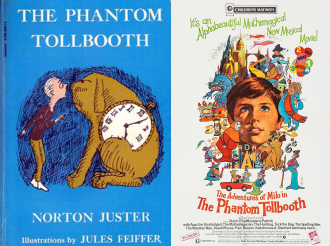This column is booked out until January. With extra bonus articles scheduled for next Easter and the Halloween after that. That’s how I work; rather than note to myself, “I should get around to that,” I add it to my calendar. (Not Disney Byways, usually, because I tend to keep that open for whim and Year of the Month, but the others, certainly.) Hence, as I said last month, I was faced with the decision of whether or not I was going to cover a book and movie that were themselves covered by a more-famous-than-I YouTuber who himself routinely covers the place where book and movie intersect? Is it now still obscure? And then I thought, “Eh, it’s my column.”
Milo is bored. Milo is always bored. “When he was in school, he longed to be out, and when he was out, he longed to be in.” And then one day, he receives a very large box labeled “To Milo, Who Has Plenty of Time.” It contains a model tollbooth, among other bits, and Milo puts the whole thing together and what with one thing and another ends up in Expectations, where he meets the Whether Man. From there, he ends up in the Doldrums, where it is illegal to think; he’s rescued by Tock the Watch Dog, who helps him get out and off to Dictionopolis.
It is there that our story really gets started. It turns out that Dictionopolis, and its sister entity Digitopolis, are halves of the divided Kingdom of Wisdom. It used to be ruled over by the twins, Sweet Rhyme and Pure Reason, but the princesses were asked by King Azaz of Dictionopolis and the Mathemagician of Digitopolis, whether words or numbers were more important. They declared them to be equal. The kings rejected this and banished them to the Castle in the Air, and the land has been in chaos ever since. Milo, Tock, the Spelling Bee, and the Humbug go off on a quest to retrieve them.
The movie is . . . broadly the same. Milo is Butch Patrick, Eddie Munster as was. The Kingdom of Wisdom is animated; this is the sole feature directed by Chuck Jones, and of course it looks it once Milo goes through the tollbooth. There are enough differences that author Norton Juster hated the movie but not so many that I feel a desperate need to detail every last one of them. There are missing characters, which seems to have been his biggest problem, but the bones of the story are there. Even a decent amount of the lesser details.
Of course, it’s a bit of a Pilgrim’s Progress story, not that I’ve ever actually read Pilgrim’s Progress. Juster freely admitted it. Milo is having to learn the value of an active mind, just as the characters in the other had to learn the value of a devoted Christian spirit. (One assumes Juster, being Jewish, was less concerned with the “Christian” part.) Milo has never been taught the value of education, so he doesn’t value it. Of course, he’s also one of those mid-century fictional heroes who doesn’t seem to have any adults in his life, never even seeming to worry about his parents, but never mind. Milo needs to Learn a Valuable Lesson About the Value of Learning, and off we go.
My own first exposure to the story was in a children’s anthology I still have around here somewhere. It included the royal banquet at Dictionopolis, and that was it. I’m not sure I ever considered seeking out the rest of it, but despite my voracious reading habits, I sought out very few of the works excerpted in those books. Strange, now I think about it. I’m not sure I read the book cover to cover until adulthood, despite also being a fan of Jules Feiffer, who did the original illustrations. Not that I think I knew that.
The one major difference in the Jones version is that the ending is considerably more heavy-handed. Jones clearly wanted to be quite sure we all knew how you fight the denizens of the Mountains of Ignorance, and how you have to use words and numbers together, and it was already pretty obvious in the hands of Juster. That part frankly dragged for me, and there had to be a more subtle way of handling it. Not that I’m convinced any adaptation necessarily could have done better, given what it had to work with.
Book or movie, it’s full of silly puns in and among the preaching. Honestly I think Jones made the right choice by having the car come with the tollbooth, because why would a kid who had a car like that be quite so bored? It’s hard enough to process that a kid of that age in San Francisco in those days wouldn’t be able to find something to do. There is a value to learning, and this is definitely one way of teaching it. Even if Juster, in recent years—he died barely three years ago—expressed amusement that kids today first had to learn what a tollbooth even is.
Next month, we’ll be getting into heavy melodrama. Join me, Olivia De Havilland, and Montgomery Clift for The Heiress. As I am not an heiress myself, consider supporting my Patreon or Ko-fi!


